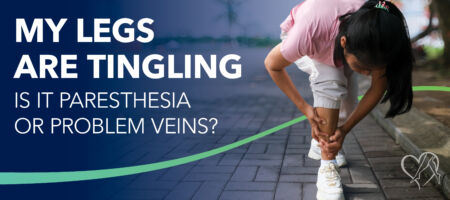
Have you ever suddenly felt tingling in your legs and wondered: Is it just ordinary “pins and needles,” or is there something more serious going on under the surface?
In many cases, tingling, also known as paresthesia, can stem from simple nerve compression. But it can also be a subtle clue to vein problems like varicose veins, spider veins, or venous insufficiency—all part of the broader category of vein disease. Here’s how to tell the difference, when to see a vein doctor, and what steps a vein specialist or vein expert might take at a qualified vein center.
Vein problems don’t get better on their own—luckily, treatment is simpler than you think. At Center for Vein Restoration (CVR), we make it easy to get relief with state-of-the-art outpatient vein procedures performed by experienced vein doctors in a comfortable setting. With more than 120 centers and acceptance of most insurance plans, high-quality vein care has never been more accessible.
Take control of your vein health today! Schedule your appointment with CVR and get back to living comfortably.
📞 Call Center for Vein Restoration at 240-965-3915
📅 Or book online HERE
CVR accepts many insurances, including Aetna, Amerigroup, Anthem, Blue Cross/Blue Shield, Cigna, MultiPlan, Medicaid, Medicare, and more.
Tingling or numbness in the legs can happen for two main reasons:
Paresthesia (nerve-based tingling)
This refers to sensations caused by nerve compression or damage. For example, meralgia paresthetica is when the nerve on the side of your thigh becomes compressed. According to the Mayo Clinic, this causes tingling, burning, and numbness, especially when you’re wearing tight clothes, are overweight, or pregnant. Peripheral neuropathy, another nerve condition, can also lead to stabbing, burning, or tingling sensations, often due to nerve damage from conditions like diabetes or certain medications, per the Mayo Clinic.
Vein-related causes (venous tingling)
This comes from issues with blood vessels—not nerves. Varicose veins are enlarged, twisted veins near the surface of the skin, often on the legs. They appear blue or purple and can cause aching, burning, swelling, and itching. Spider veins are smaller, red or purple lines that resemble webs; they’re typically milder but still part of vein disease.
If venous problems worsen, they can lead to chronic venous insufficiency (CVI), a condition where leg veins fail to return blood efficiently to the heart. This causes blood pooling, leg swelling, aching, heaviness, skin discoloration, ulcers, and yes, tingling or burning sensations.
Recent coverage about President Trump's chronic venous insufficiency highlights CVI symptoms like swelling, tingling, and varicose veins, often linked to weakened vein valves, blood clots, or prolonged sitting or standing.

Tingling legs can be tricky to diagnose because both nerve issues (paresthesia) and vein problems share similar symptoms. Looking for patterns in your discomfort and any visible changes in your legs can help point you in the right direction.
Here’s how to tell whether your tingling is more likely linked to your veins or to nerve compression.
Red flags for vein causes include:
Red flags for paresthesia include:

Ignoring tingling in your legs or guessing at the cause can delay the right treatment and prolong your discomfort. The first step is determining whether your symptoms are coming from your veins or from compressed or irritated nerves. A vein expert at Center for Vein Restoration (CVR) is trained to pinpoint the difference and guide you to the right solution.
At a CVR vein center, your evaluation usually starts with a detailed conversation about your symptoms and health history, followed by a physical exam and a painless, noninvasive leg ultrasound. This test lets the physician see how well your vein valves are working and whether blood is pooling in your legs: a sign of venous insufficiency or vein disease.
If the culprit is vein-related, your CVR vein specialist will create a personalized treatment plan. This may include simple lifestyle strategies such as walking, leg elevation, and compression stockings, or minimally invasive procedures such as sclerotherapy, radiofrequency ablation, or laser therapy to close off faulty veins and restore healthy circulation. These outpatient vein procedures are quick, performed under local anesthesia, and designed to get you back on your feet the same day.

According to the Cleveland Clinic, if your tingling is caused by paresthesia, it’s often harmless, like when your leg “falls asleep” from sitting too long, and may improve with simple fixes such as looser clothing, better posture, or weight loss to relieve nerve pressure. But if the tingling happens frequently or comes with other symptoms, see your doctor. They can determine whether you need further evaluation or referral to a neurologist or physical therapist for targeted treatment.
Center for Vein Restoration, America’s largest physician-led vein center, makes it simple to get answers. With 120+ locations in 22 states, 80+ board-certified vein doctors, and a 98 percent patient satisfaction rating, CVR offers trusted, compassionate care that’s close to home. Schedule your consultation today and take the first step toward relief—whether your solution is vein treatment or nerve care guidance, we’ll help you get there.
Try these steps to stay ahead of leg tingling and discomfort:
👉 Book your consultation with a CVR vein specialist today and discover how simple relief can be.
When your legs tingle, it could be as simple as nerve pressure or a sign of vein problems like venous insufficiency or vein disease. Don’t shrug it off. Your vein specialist can clear up the confusion, ensuring you get tailored vein treatment or nerve-focused advice. Early action helps prevent complications and helps you feel better faster.
By first identifying the root cause, CVR ensures you receive the right treatment—whether that’s expert vein care or a nerve-focused solution—so you can stop wondering, start healing, and get back to living without discomfort.
